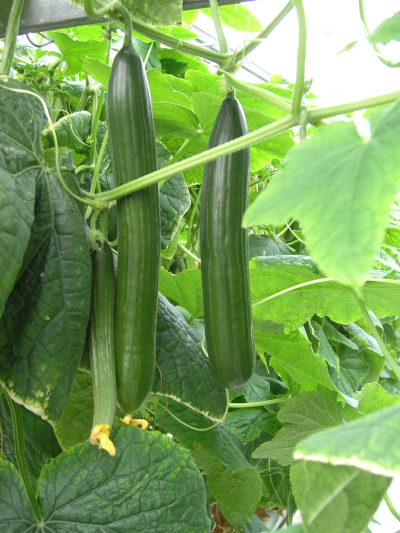
March 9, 2010 – The genome
of the cucumber has been
sequenced by an international consortium led by Chinese and U.S.
institutions,
including the University of California, Davis.
March 9, 2010 – The genome of the cucumber has been
sequenced by an international consortium led by Chinese and U.S. institutions,
including the University of California, Davis.

|
|
|
|
The annotated genome was published
online last fall by the journal Nature Genetics. The cucumber genome will give
insight into the genetics of the whole cucurbit family, which includes pumpkins
and squash, melon and watermelon, and will be a platform for research in plant
biology, said William Lucas, professor and chair of the UC Davis Department of
Plant Biology. Lucas helped develop and manage the project and is an author on
the paper. “This is going to help a large community of scientists – we can now
go 10 times faster than we could before,” Lucas said. Lucas studies the
vascular transport systems, phloem and xylem, that plants use to move
nutrients, minerals and signaling molecules throughout their tissues.
Pumpkins and cucumber are model
plants for studying vascular transport, because their vascular system is large
and easy to access. Lucas’ research group has shown that plants use both
proteins and RNA – molecules copied or transcribed from
DNA – as signaling molecules that are transported around the plant through the
phloem. These signals can affect plant growth, coordinate activity through the
plant and help it fight infection.
For example, in 2007 they showed
that “florigen,” the signal that tells the growing tips of plants to make
flowers in response to seasonal changes, is a protein transmitted through the
phloem.
The new study identified 800 phloem
proteins in the cucumber genome. With the help of the genome data, researchers
will be able to rapidly identify and characterize all the protein, RNA and
other molecules in the phloem sap, Lucas said.
There are already indications that
far more is going on in the phloem than anybody had previously expected, he
said. The study shows that five of the seven chromosomes in cucumber arose from
10 ancestral chromosomes shared with melon, and that gene-coding stretches of
cucumber DNA share about 95 per cent similarity to melon.
Preliminary studies in Lucas’ lab at
UC Davis have established comparable similarity between cucumber and pumpkin.
The cucumber genome will also provide insights into traits such as disease and
pest resistance, the “fresh green” odour of the fruit, bitter flavors, and sex
expression – how the plants form flowers and fruit.
The cucumber is the seventh plant to
have its genome sequence published, following the well-studied model plant
Arabidopsis thaliana, the poplar tree, grapevine, papaya, and the crops rice
and sorghum.
The sequencing effort, begun earlier
this year, was coordinated by Professor Sanwen Huang of the Chinese Academy of
Agricultural Science and included the Genome Centre at the Beijing Genome
Institute-Shenzhen and UC Davis as well as several laboratories in China and
others in the U.S., Denmark, the Netherlands, Australia and South Korea.
Part of the effort relied on new
methods developed by the Beijing Genome Institute to assemble short pieces of
DNA, about 50 base pairs, into the sequence. The Beijing Genome
Institute-Shenzhen can now sequence and assemble genomes much faster, and at
lower cost, than previously possible, Lucas said. “This will be the forerunner
for many genomes done at a cost-effective rate,” he said.
Andy Fell is a communications specialist with the UC Davis News Service.
Print this page